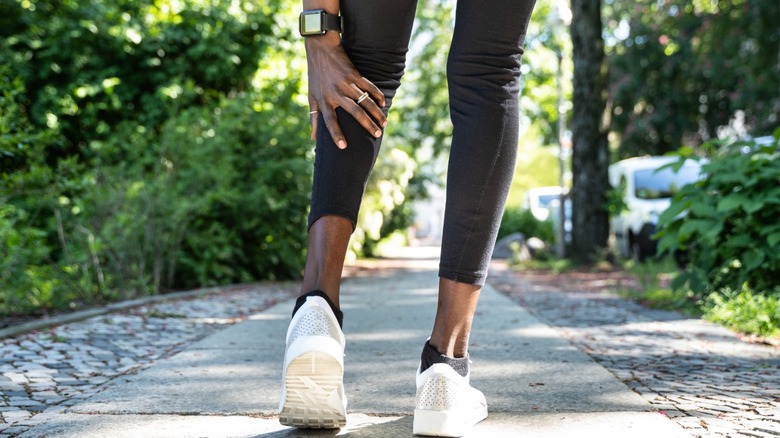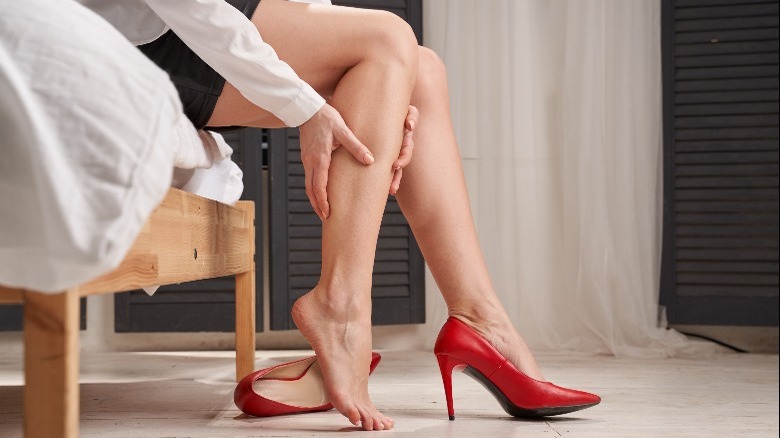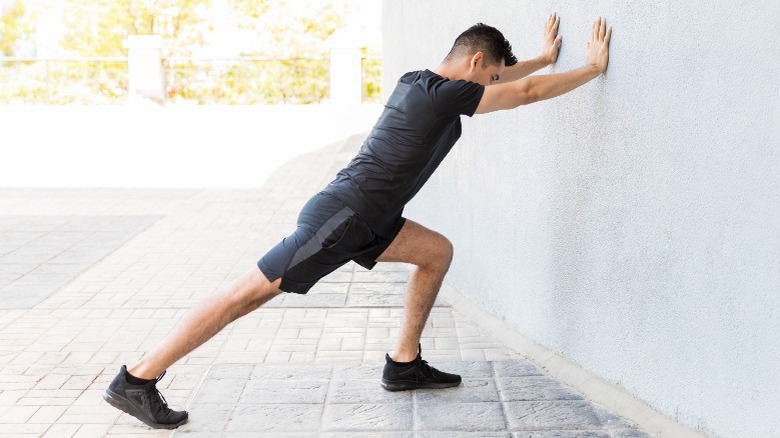The Best Stretches For Your Calves
If you engage in active cardio activities like running, swimming, or brisk walking regularly, you may find that your calves can get super tight. Tight calves are not necessarily painful, so you may not wonder why it is important to give them a stretch.
Your calves are made up of two muscles — the gastrocnemius and the soleus. These muscles connect to your knees and the back of your heels, and Self notes that they help support your everyday movements. Your calf muscles also help you perform other actions, such as standing on your toes to reach a high shelf or pressing down on a gas pedal. It's not unusual for your calves to become tight, especially if you don't allow them to have the full range of motion on a consistent basis. For example, it might occur if you sit at a desk all day, wear high-heeled shoes, or wear running shoes that hamper your foot from rolling between the heel and toe. These circumstances keep your calf muscles in a shortened position, causing them to become tight and more prone to cramps or injuries in your knees or feet. Additionally, certain medications and medical issues can also lead to muscle cramps, per the Mayo Clinic.
Other possible causes of tight calf muscles
You don't necessarily have to exercise on a regular basis to experience the dreaded Charley horse, that involuntary muscle spasm or painful cramp that seemingly comes out of nowhere. According to MedlinePlus, there are several potential causes for a Charley horse, including exercising when you are dehydrated or low levels of minerals, such as calcium or potassium. A Charley horse can also be the result of an irritated nerve connected to the calf muscle.
However, Healthline notes that there could be more serious underlying issues causing tight calf muscles or calf pain, such as poor circulation, a muscle tear or injury, peripheral vascular disease (PVD), or deep vein thrombosis (DVT), among others.
Most of the time, leg cramps are harmless and respond well to stretches and simple home treatments. Healthline recommends making calf stretches a part of a regular routine to help prevent tightness and possible pain or injury in the first place.
These simple calf stretches will keep you pain-free
Adding calf stretches to your day is easy, and Shape provides a number of options. One example involves resting both hands on a wall and extending one leg behind you while keeping both feet flat on the ground. Then, gently bend your front knee. You should feel a gentle stretch in the back calf. Hold this pose for 10 to 15 seconds and repeat on the other side.
If you are somewhere that does not have a wall, you can try a different stretch — in a standing position, just cross your left leg in front of your right leg, keeping your feet next to each other. Then, slowly roll down and hang for roughly 30 seconds. You should feel some tension in the right calf. Alternate your legs and repeat.
A good stretch to do on the floor is the toe pull stretch. Sit on the floor with your legs out straight with flexed feet. Lean over your legs, reaching for the arches of your feet until you feel your calf muscles engage. Zika Palmer, an elite marathoner, told Shape that doing these stretches after each run can give you a smoother stride within six weeks
Along with these stretches, some treatments can help if you are experiencing pain in your calf muscles — a massage, over-the-counter pain relievers, or R.I.C.E (rest, ice, compression, and elevation). If your pain persists, consider contacting your doctor, per the Cleveland Clinic.



